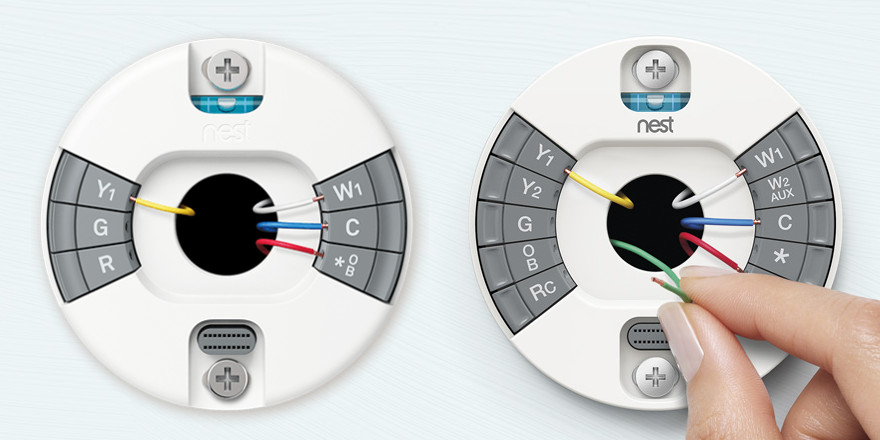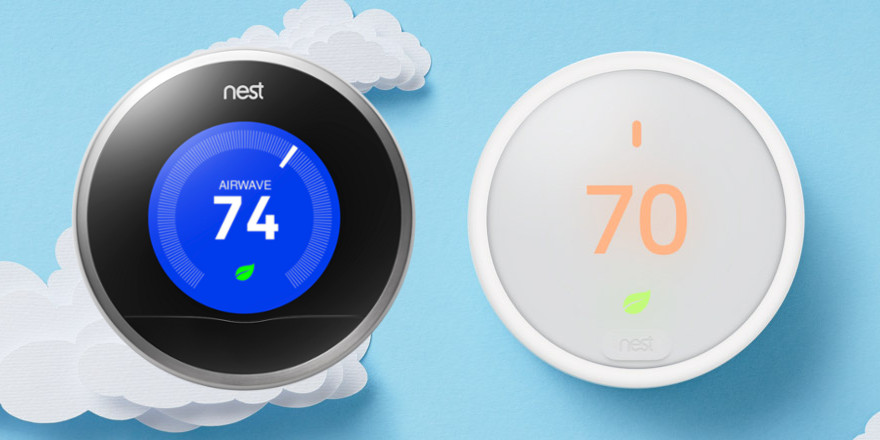As of September, Nest has released a brand new thermostat: the Nest E. And with its release have come a lot of questions, mainly, “What’s the difference between the Nest and Nest E?” To keep it short, the main differences are that the Nest E has a lighter price tag, a few less features/connectivity, a little less choice in cosmetics, and is a little smaller in comparison to the Nest Learning Thermostat. So, you could probably leave the article now if you just wanted to be someone in the know. However, if you’re looking to decide which one to get, we’d suggest reading about the differences below.
Nest vs. Nest E — Differences
-
Difference #1: Display/Resolution – One of the first major differences between the two thermostats is their display and resolution. First, the display: the Nest Learning Thermostat has a display diameter of 2.08 in (5.3 cm), while the Nest E Thermostat has a diameter of 1.78in (4.5cm). An extra quarter of an inch in diameter may not seem like much, but it’s definitely worth mentioning.
As for the resolution, the Nest Learning Thermostat takes the cake here as well. The Nest Learning Thermostat has a 480×480 resolution with 229 pixels per inch, while the Nest E Thermostat has a 320×320 resolution with 182 pixels per inch. The Nest Learning Thermostat has a larger, denser resolution, making it a bit easier on the eyes.
But we should mention that this is kind of what the Nest E is going for: they’d like big bubbly letters that softly shine through a frosted glass display — The Nest E is less geared toward tech-spec chasers and more towards those who want an aesthetic piece on their wall.
All in all,technically, when it comes to both display and resolution, the Nest Learning Thermostat wins out against the Nest E.
-
Difference #2: Connectivity – The Nest Learning Thermostat is estimated to work with 95 percent of homes, making it the more “connected” thermostat of the two. The Nest E Thermostat is compatible with fewer heating and cooling systems (mostly higher-end ones, Nest says, like those that include a humidifier), but it’s still supposed to be good for 85 percent of homes. We’ve put together a table below to help you see the difference in connectivity with for both Nest thermostats below.
It’s important to note that while the Nest E can support W2 and Y2 wires, it can only have one of these connected to it (via the OB slot). In short, if you have W1, W2, Y1, and Y2 wires, you can only connect either the W2 or Y2 wire to the Nest E Thermostat.
-
Difference #3: Farsight Feature – There’s only one feature that the Nest Learning Thermostat has that the Nest E Thermostat won’t and it’s a feature called “Farsight.” The Farsight feature lets the Nest Learning Thermostat notice when you’re across the room and then turn on its display to show you the time or temperature. We’ve got no idea as to why anyone wanted this feature from a tiny thermostat screen in the first place, but maybe some people find it useful? We don’t think you’d really miss out on much without this feature.
-
Difference #4: Size and Weight – The size of the two thermostats is incredibly similar. The Nest Learning Thermostat is 3.3in (8.4cm) in diameter and is 1.21in (3.08cm) in height. The Nest E Thermostat is slightly smaller with a diameter of 3.19in (8.1cm) and is 1.14in (2.89cm) in height.
Now, we don’t think the weight will be much of a factor in determining which thermostat is the better choice, but we figured we should mention it, as it is a difference. The Nest Learning Thermostat weighs in at 8.6oz (243.7g) while the Nest E Thermostat is nearly half the weight at 4.9oz (139g). The Nest Learning Thermostat is super dense in comparison to the Nest E, but they’re going on the wall — You’re not going to be carrying it around in your pocket.
-
Difference #5: Color – The Nest E Thermostat only comes in white. The Nest Learning Thermostat, on the other hand, comes in 4 colors: white, copper, black, and stainless steel. If you don’t think that a white thermostat will blend well in the room you choose, well, the Nest E says, “Tough Luck.” If you’re looking for options other cosmetic options, the Nest Learning Thermostat is the one to go with.

| Nest Learning Thermostat | Nest E Thermostat | |
|---|---|---|
| Heating | 3 Stages (W1, W2, W3) | 2 Stage (W1, and W2 OR Y2) |
| Cooling | 2 Stages (Y1, Y2) | 2 Stages (Y1, and Y2 OR W2) |
| Heat Pump | O/B, AUX, E | O/B, AUX |
| Humidifier or dehumidifier | HUM, DEHUM | N/A |
| Fan | G | G |
| Power | C, Rh or Rc | C, Rh or Rc |
-
Difference #6: Warranty – This is a serious difference, because who knows what could happen with a new tech gadget (especially a newly released one that, you know, controls the temperature in your home). The Nest Learning Thermostat has a 2 year warranty whereas the Nest E Thermostat only offers a 1 year warranty. Again, the edge goes to the Nest Learning Thermostat on this difference.
-
Difference #7: Cost – By now, you’ve got to realise that the Nest E Thermostat is the lesser of the two models, and they’ve done it to help bring more people into the smart home niche. You’re getting most of the functionality, with a few missing features. So, it’s a no-brainer that the cost is going to be a major difference. The Nest Learning Thermostatis more expensive than the Nest E Thermostat. You’ll have to weigh compatibility and features when deciding which of the two Nest thermostat models fits your needs — Because they’re both solid options.
Nest E vs. Nest Learning Thermostat — Comparison Chart
| Nest Learning Thermostat | Nest E Thermostat | |
|---|---|---|
| Display | 24-bit color LCD | 24-bit color LCD |
| Pixels Per Inch (PPI) | 229 | 182 |
| Resolution | 480 x 480 | 320 x 320 |
| Heating | 3 Stages (W1, W2, W3) | 2 Stage (W1, and W2 OR Y2) |
| Cooling | 2 Stages (Y1, Y2) | 2 Stages (Y1, and Y2 OR W2) |
| Heat Pump | O/B, AUX, E | O/B, AUX |
| Humidifier or dehumidifier | HUM, DEHUM | N/A |
| Fan | G | G |
| Power | C, Rh or Rc | C, Rh or Rc |
| Frosted Display Design | No | Yes |
| Farsight Feature | Yes | No |
| Diameter | 3.3 in (8.4 cm) | 3.19 in (8.1 cm) |
| Color Options | White, Copper, Black, Stainless Steel |
White |
| Ring | Metal, Polished Finish | Polycarbonate Finish |
| Warranty | 2 Years | 1 Year |
Nest Learning Thermostat vs. Nest E — Our Thoughts

The Nest Learning Thermostat and the Nest E Thermostat are targeting two different customers. If you’re looking for a solid warranty and are chasing specs and functionality (which we are), the Nest Learning Thermostat is the thermostat to go with. If you’re looking for thermostat that you can just buy and forget about, yet still get all the benefits that come with having some intelligence built-in, the Nest E Thermostat is the choice.
Whichever your choice, Nest thermostats are a staple in a smart home. And if for some reason you’re feeling a bit wary about either Nest option, check out our writeup of ecobee vs. Nest and see if they’re the thermostat for you.
Update 05/05/18: You can now buy the Nest Temperature Sensors to even out the temperature between rooms in your home. The Nest Temperature Sensors work only with the Nest Learning Thermostat Gen 3 and the Nest E Thermostat.
Last update on 2024-04-25 at 11:00 / Affiliate links / Images from Amazon Product Advertising API





I have read so many articles or reviews on the topic of
the blogger lovers except this article is in fact a fastidious
article, keep it up.
Hey! Do you use Twitter? I’d like to follow you if that would be ok. I’m definitely enjoying your blog and look forward to new updates.
We have Twitter (@JustClick_), however we aren’t too active on it. But with a comment like this, we’ll try to get involved more soon.
I’m not sure why you are claiming that the Nest E supports 2 stages of both heating and cooling. It can only support one or the other.
Hey Jake,
We took the connectivity specs for the Nest E straight from the Nest website:
“Heating and Cooling: 1 stage of heating (W1) and cooling (Y1) and a second stage or either heating (W2) or cooling (Y2).”
So, the table is tough because the Nest E does support second stages of heating and cooling (with it’s OB connection). However, it’s an either/or scenario, as both second stages cannot be connected simultaneously. It’s better for us to note the connectivity as W1 and Y1 both connected, however if you have a W2 and/or Y2 wire(s), Nest E only supports one of them with its OB slot; there is no second OB slot for both the W2 and Y2 wires.
We’ll find a better way to display/communicate this. Thanks for the feedback, it helps us in delivering a more understandable synopsis.
– Joseph
I am just starting to learn about all of this. Thanks!
Hi,
I’ve got two older thermostats; one for a natural gas fireplace and one for a natural gas furnace; probably from 2002 or so. These show RH, RC, W, Y, G. Current fireplace connect to red to RC and white to W. Furnace wires are white to W, red to RH and jumped to RC and green to G. I’m hoping the NEST will work with my set up but it seems maybe not?
thanks,
gabe
Hi Gabe,
We’d recommend asking a professional to take a look at your wires. And you can also check compatibility with this Nest tool to make sure the Nest thermostat will work in your home.
Best of luck in your smart home setup!
– Iryna
Late to the party here BUT I have a 2nd Gen Nest whose wifi chip has just failed. Looking at E vs. Learning. Is Farsight the feature that senses whether there is any activity in the home that initiates the “away” feature? That’s a big minus if the E can’t do that. I depend on that kicking in, esp. for heating, when leaving the house for an extended time. Or do both models include that?